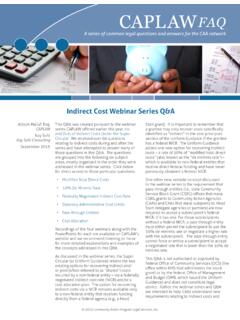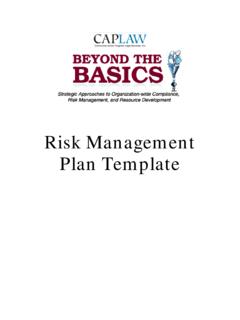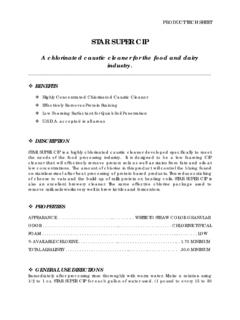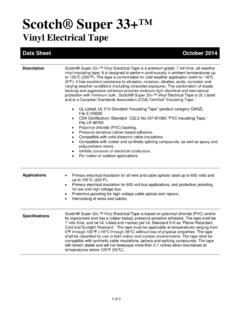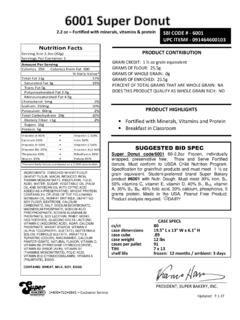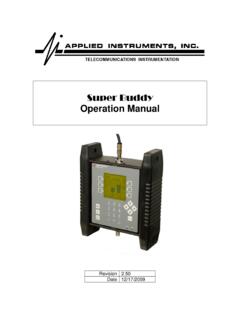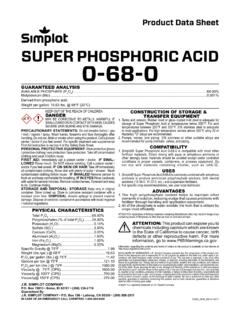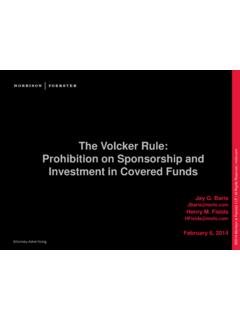Transcription of Navigating the OMB Super Circular Changes - …
1 Legal and financial information for the Community Action networkspecial edition 2014 Inside This Issue : Navigating the OMB Super Circular Changes (cover) Administrative Requirements Review (page 7) Cost Principles Analysis (page 14) Audit Highlights (page 21) Navigating the OMB Super Circular ChangesBy Eleanor A. Evans, Action Agencies (CAAs), states and other entities receiving federal grant funds are readying themselves for significant Changes to the rules governing how they spend and administer their federal grant funds, which will take effect later this year.
2 These new rules are known informally as the OMB Super Circular or Omni Circular . This newsletter provides an overview of the Super Circular Changes to assist CAAs and other Community Services Block Grant (CSBG) organizations in Navigating the Super Circular and in preparing to comply with its requirements. This initial Q&A focuses on overarching aspects of the Super Circular and is followed by articles that walk through the Changes to the uniform administrative requirements, federal cost principles, and audit requirements. Stay tuned for future updates and clarifications on the Super Circular from Is the Super Circular and Why Was It Issued?
3 The federal Office of Management and Budget (OMB) issued the Super Circular on December 26, 2013 in the form of final regulations officially titled Uniform Administrative Requirements, Cost Principles, and Audit Requirements for Federal Awards. For purposes of the Super Circular , the term federal award includes federal grants, cooperative agreements and other agreements for federal assistance, such as, loan agreements. (This newsletter uses the term federal grant interchangeably with the term federal award. )The Super Circular supersedes and streamlines requirements from the following OMB Circulars applicable to the administration, use and audit of federal grant funds by nonprofit organizations, state, local and tribal governments, and colleges and universities.
4 A 122 (Cost Principles for Non-Profit Organizations) A-87 (Cost Principles for State, Local and Indian Tribal Governments)Continued on page 3 CAPLAW Update Newsletter, Special Edition 2014 | 3 A-21 (Cost Principles for Educational Institutions) A-110 (Uniform Administrative Requirements for Grants and Agreements with Institutions of Higher Education, Hospitals and Other Non-Profits) A-102 (Grants and Cooperative Agreements with State and Local Governments) A-89 (Federal Domestic Assistance Program Information) A-133 (Audits of States, Local Governments and Non-Profit Organizations) A-50 (Audit Follow-Up).
5 1 The Super Circular is divided into six parts: Subpart A Acronyms and Definitions; Subpart B General Provisions; Subpart C Pre-Federal Award Requirements and Contents of Federal Awards; Subpart D Post-Federal Award Requirements; Subpart E Cost Principles; and Subpart F Audit also includes 11 appendices. Of particular note to CSBG network organizations are: Appendix I Full Text of Notice of Funding Opportunity; Appendix II Contract Provisions for Non-Federal Entity Contracts under Federal Awards; Appendix IV Indirect (F&A) Costs Identification and Assignment, and Rate Determination for Nonprofit Organizations; Appendix V State/Local Government and Indian Tribe-Wide Central Services Cost Allocation Plans.
6 And Appendix VII States and Local Government and Indian Tribe Indirect Cost Super Circular s primary objectives include : eliminating duplicative and conflicting guidance; focusing on performance over compliance for accountability; encouraging efficient use of information technology and shared services; providing for consistent and transparent treatment of costs; limiting allowable costs to make best use of federal resources; encouraging non-federal entities to have family-friendly policies; strengthening oversight; targeting audit requirements on risk of waste, fraud and OMB developed the Super Circular in response to directives from President Obama regarding reducing unnecessary regulatory and administrative burdens, redirecting resources to services that are essential to achieving better outcomes at lower cost, and strengthening accountability by intensifying efforts to eliminate payment error, waste, fraud and abuse.
7 In doing so, OMB worked with the Council on Financial Assistance Reform (COFAR), an interagency group of federal executive branch officials that coordinates government-wide financial assistance initiatives. OMB published an advance notice of proposed guidance in February 2012 followed by a notice of proposed guidance in February 2013, both of which solicited public input on the grant reform proposals and invited the public to make additional reform recommendations. The public responded with more than 300 comments on each of the two response to over 200 questions and comments received since the final Super Circular regulations were published in December 2013, the COFAR has issued Frequently Asked Questions (FAQs) on implementation of the Super Circular .
8 The COFAR s August 29, 2014 FAQs include and update the FAQs it issued earlier in the year. The COFAR plans to continue issuing more FAQs in the future in response to additional comments and questions on the Super Circular , which may be submitted to the COFAR by email at A training webcast and other resource materials on the Super Circular are also available on the COFAR Whom Does the Super Circular Apply?The Super Circular applies to federal agencies that make federal awards to non-federal entities (such as states or CAAs), as well as to non-federal entities that receive federal grant funds.
9 Under the Super Circular , a non-federal entity receiving federal grant funds may be a direct recipient of those funds (such as a state receiving Weatherization Assistance Program funds from the Department of Energy or a CAA receiving Head Start funds directly from the Department of Health and Human Services Administration for Children and Families) or a subrecipient receiving federal funds through a subaward The Super Circular applies to federal agencies that make federal awards to non-federal as well as to non-federal entities that receive federal grant Navigating the Super Circular (continued from cover)Continued on page 44 | CAPLAW Update Newsletter, Special Edition, 2014(such as a CAA receiving CSBG funds from a state or a child care partner organization receiving Head Start funds from a CAA).
10 Any non-federal entity that provides a subaward to a subrecipient to carry out part of a federal program is considered a pass-through entity. Thus, as noted above, in some cases, a CAA may be a recipient or a subrecipient; in other cases, it may be a pass-through entity (such as when it makes a subaward of Head Start funds to a delegate agency or child care partner organization).Different rights and responsibilities apply to non-federal entities depending on whether they are recipients, subrecipients or pass-through entities. Pass-through entities are required to follow the Super Circular requirements applicable to pass-through entities but not requirements directed toward federal awarding agencies unless the Super Circular or the terms and conditions of their federal awards specifically indicate Do All the Requirements of the Super Circular Apply to All Federal Grant Programs?
